Why Is My Toilet Water Yellow? 7 Likely Reasons
-
Pete Ortiz
- Last updated:
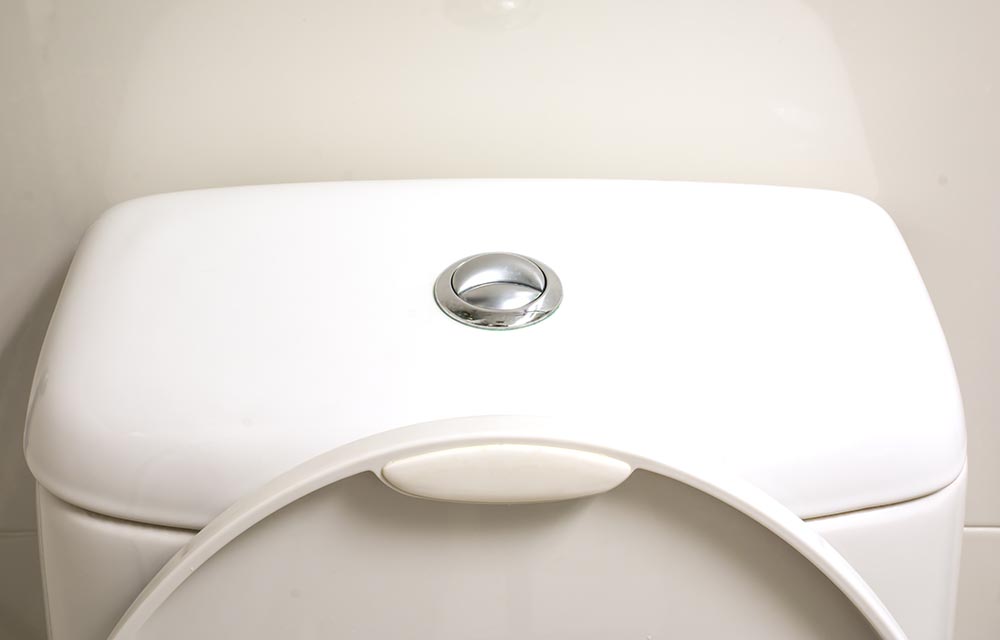
The first thing that comes into most people’s minds when they see yellow water 1 in the toilet is “somebody forgot to flush after use.” However, this is not always the case. There are many other reasons your toilet water may be yellow.
Consider flushing the toilet immediately to eliminate the possibility that someone forgot to flush. If the water is clear and clean after flushing, talk to your family about the importance of flushing the toilet after use.
However, if the water that comes out is yellow, you have an underlying problem beyond flushing on the cistern or in any other part of the toilet. This article covers some of the likely causes of yellow toilet water. Keep reading for deeper insight.
7 Possible Reasons the Toilet Water Is Yellow
1. Availability of Hard Water
Water is not always hard when it comes down from the clouds as rain; it is pure. However, it picks up minerals 2 such as copper, magnesium, zinc, calcium, and manganese as it passes through the soil and rocks on its way to the water sources. These minerals are not harmful to our health; in fact, they are quite helpful in improving our body’s functionality.
However, when this water reaches our households through pipes, it leaves mineral deposits. The minerals pile up for a long time to the point that you can begin to see white residue on bathtubs, sinks, and toilets. Eventually, the residue turns yellow and is carried by the water running through the pipes into the toilet basin. Hence the yellow water in the toilet each time you flush it.
2. Rust
Parts of the toilet are made of metal; for instance, bolts hold things in place in the toilet cistern. When these bolts are exposed to water for a long time, they begin to rust and form yellow water that will be observed when you flush the toilet.
Apart from the bolts in the cistern, rust also occurs in old water pipes, especially if you are living in older houses built before the 1960s; those houses were installed with water pipes made from galvanized steel or iron for durability. However, after a while of exposure to water, they begin to rust.
Therefore, if you notice yellow water in your toilet, it could be due to the formation of rust either in the toilet’s cistern or in the pipes of old houses.
3. Standing Water in the Toilet Bowl
Picture that guest room you rarely visit unless you have some visitors over. You most likely never flush the rarely used toilet in that room. When water is left standing in the toilet bowl for too long, it begins to turn yellow, often due to dust, bacteria, and mineral residue accumulation.
If you are not always around to ensure regular toilet flushing, consider hiring a local property manager to regularly inspect your household and ensure the toilets are cleaned and flushed.
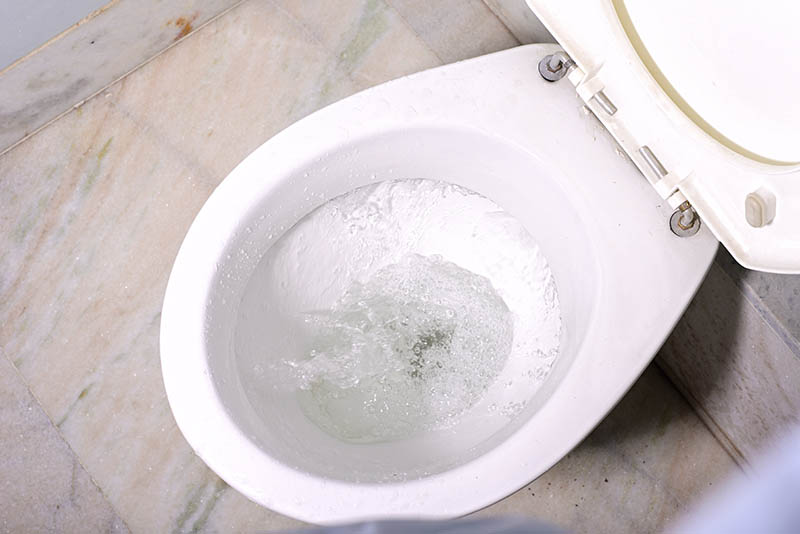
4. Water Supply Contamination
Water contamination may happen when wastewater from the sewer pipes ends up in your toilet. Often, the sewage backflow is due to the blockage of sewage pipes or an overflowing septic tank.
Apart from the yellow water, you will also notice an awful smell. Contact a professional plumber immediately if you notice such signs as sewage-contaminated water can lead to serious health hazards.
5. Municipal or Local Repairs in Progress
The water in your toilet will obviously turn yellow when repair works are currently taking place. In most cases, the water has to be turned off and then on when the repairs are complete. However, dust and soil particles gather in the water pipes when the water is turned off.
When the repairs are done, and the water is back on again, it carries these dust particles into your toilet and taps, hence the yellow discoloration.
The discoloration could also be as a result of the municipality flushing out mineral residue accumulated in the water pipes. When the particles detach themselves from the walls of the pipes, they get into the water, turning it yellow. When the flushing is over, the water will be back to normal.
6. Use of Water Softener’s Salt
Did you know that some water softener salts turn water yellow? This happens especially if the water softener salt leaves residue in the water. You would have already seen this if you had tried putting salts in the yellow bag in a water-softener resin.
You can also observe yellow toilet water if you have recently started using a water softener. If it is new, it shouldn’t take long before the water returns to normal after regenerating severally. However, if the water does not clear after a while, the water softener resin may be of a poor quality, and you may consider getting another one.
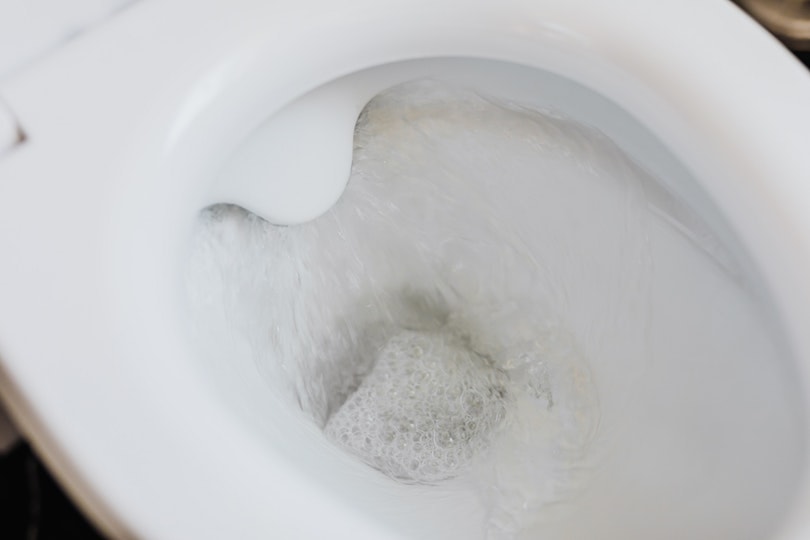
7. High Concentrations of Iron
Iron is among the minerals that water may contain in addition to copper, magnesium, zinc, calcium, and manganese. However, when the iron is of higher concentration, the water automatically turns yellow. High concentration of iron also contributes significantly to the rusting of fixtures like bathroom, toilet, and kitchen faucets.
Is the Yellow Toilet Water Harmful?
The answer to whether yellow toilet water is harmful to human beings may not be definitive. Since the toilet water is not used for consumption-it is used to flush the toilet and keep it clean, we can say that the yellow toilet is not harmful in that capacity.
However, it may go more than that; harm may be considered depending on what is causing the water to turn yellow.
For instance, if the toilet water turns yellow due to sewage backflow, the situation could also be affecting other water sources in the house, especially in the kitchen. Therefore the yellow water in the toilet could be a huge sign of an impending health hazard.
As much as toilet water cannot directly harm us, the water could cause harm to pets in the house. It is known that some cats and dogs often drink from the toilet. Suppose they drink yellow water contaminated by waste from sewer pipes or municipality repairs; the pets could also be in danger of serious health conditions.
However, checking the water from the kitchen taps and other faucets is advisable each time you notice yellow water in the toilet. That way, you will not consume contaminated water, and you can always determine whether the yellow residues in the water are only affecting your toilet or your entire household.
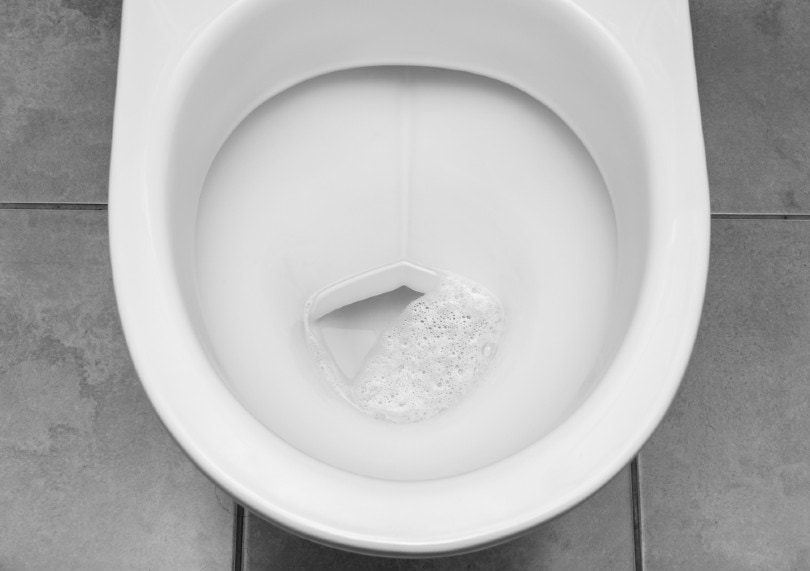
Possible Solutions to Yellow Toilet Water
With the above information, you can pinpoint what could be causing toilet water to turn yellow. It is obvious that you don’t want the unsightly scene in your toilet, and so you will want to remedy the situation. Below are some tricks to remedy the embarrassing situation.
Leave the Water Running for a Few Minutes
Water will clear after a while if you leave it running for a few minutes, but only if it has turned yellow due to ongoing municipal or local repairs. Therefore, open the water faucets in the bathroom and kitchen.
However, it is advisable to be sure that it is the repair that caused the discoloration of the water; make a call to the water company and ask.
You will also be required to flash the toilet a few times for the yellow water to be completely flushed out and not cause any stubborn yellow stains on the toilet basin.
Repair or Replace Damaged Pipes
It is not always easy to know whether the cause of the yellow water is damage to sewer pipes. Though, on a few occasions, when the damage is too much, you will notice sewage backflow into the toilet, faucets, and taps.
Once it is clear that the yellow toilet water has been caused by leaking or damaged sewer pipes, hire professional plumbers to repair the damaged areas or do a complete replacement of the pipes. An immediate fix is important as sewer leakage into water pipes leads to health hazards.
Also be keen to inspect your sewer system and toilet supply pipes regularly to prevent such issues
Flush the Toilet Frequently
You can easily forget to flush a toilet you rarely use in your house. The problem is that the longer the toilet water stays stagnant, the more dust it gathers, turning yellow and staining your toilet. Make a habit of visiting that guest room you rarely get into, and flush the toilet at least once daily.
Suppose you are rarely home and the toilets in your house have to stay with stagnant water for days or weeks before you come home; consider hiring some help. A local property manager can be quite helpful in making sure that all the toilets in the house have been cleaned and flushed daily to avoid the accumulation of yellow water.
Treating the toilet with baking soda or household bleach before leaving is also a perfect idea for preventing the stagnant water that is turning yellow in the toilet from staining the toilet.
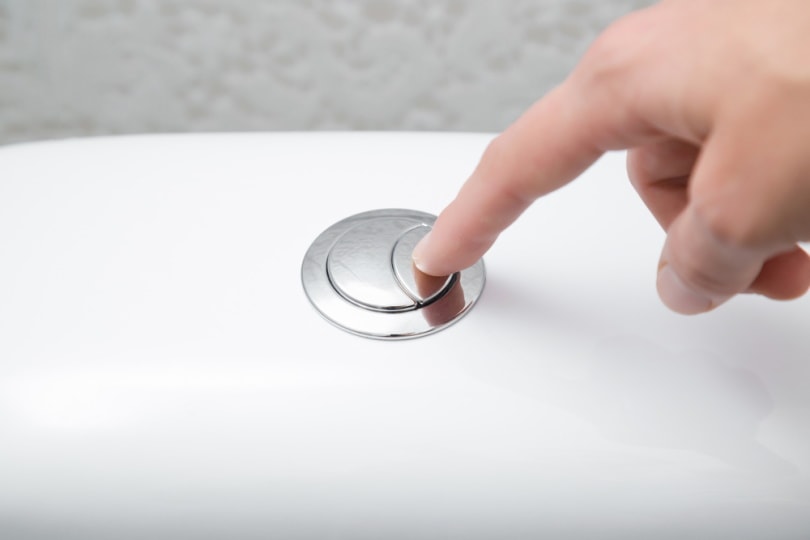
Clean Off the Rust in the Toilet Cistern
After it has been established that the rust from the bolts in the toilet system is the reason for the formation of yellow toilet water, lift the cistern’s lid to access the rusting parts. You can only clean the rust if there is no water in the tank; therefore, ensure no water is running into the tank and flush the existing one.
Use a bristle brush to scrub the rusty parts of the cistern gently. When you are done scrubbing, allow the water to run into the tank and flush the toilet a few times. Suppose the bolts are too rusty to be cleaned by a simple scrub, consider replacing them.
After cleaning or replacing rusty bolts, pour a cup of hydrogen peroxide solution into the cistern at least once per month. The hydrogen peroxide solution is known to prevent further rusting of bolts and the formation of limescale. Alternatively, pour some vinegar into the tank and let it stay for about ten to twelve hours before flushing.
Replace Old Rusty Pipes
Suppose you live in an old apartment whose pipes were built with older materials. The chances are the water pipes are already rusty, and the corroding particles are the ones causing your toilet water to turn yellow.
The best solution is to hire professional plumbers that will remove the older water and replace them with modern ones that do not rust too easily. They may as well get rid of all the iron pipes in the house since they eventually begin to rust and corrode. Also, installing a water filter to filter out rust residue before coming through the water faucets is recommended.
Fix the High Iron Concentration in the Water
Suppose you suspect that the main reason your toilet water is turning yellow is the existence of too much iron. You should call your local water company. The experts will conduct their usual tests and determine the iron concentration in the water. If it is too much, they should be in a position to remedy the situation.
Install a High-Quality Resin for Your Water Softener
A water softener machine is designed to eliminate the existence of minerals like calcium and magnesium in the water. Even though you may notice some yellowish water if you begin using a different type of water softener salt, the situation should be able to remedy itself if the resin regenerates a couple of times.
However, if the situation does not change, you may need a high-quality water softener resin.
When purchasing your water softener machine, ensure it is a salt-based water softener. Avoid using a salt-free system since it is not efficient enough to eliminate all the minerals that cause yellow stains in water. Also, ensure the water softener machine you choose is NSF 44 certified.
Install a Chlorine Injection System
A chlorine injection system is designed to remove the yellowish or brownish particles contaminating the water. They function by injecting chlorine into the water, which is filtered out with carbon filters before it is released into the house.
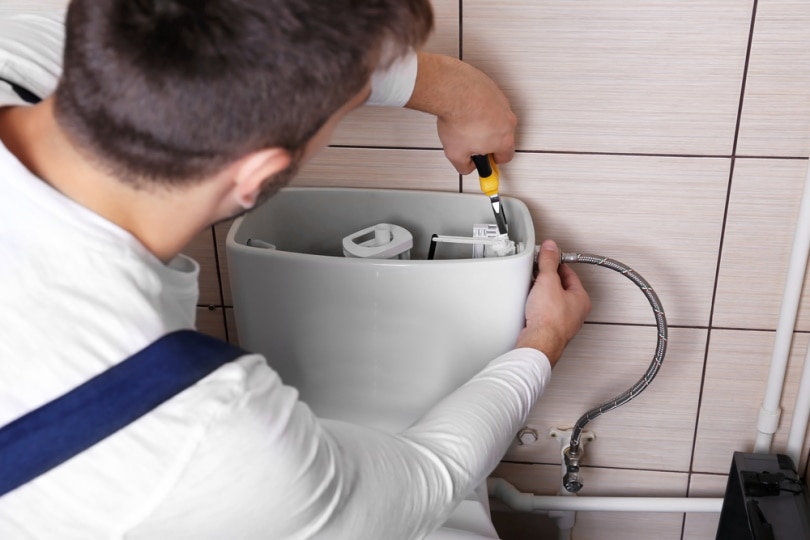
How to Remove the Yellow Stains Caused by the Yellow Toilet Water
Yellow toilet water may eventually begin discoloring the toilet bowl. If that is the case for you, consider the following cleaning method to eliminate the stain.
You will need a toilet brush, white vinegar, and baking soda.
- Cover the yellow stains with baking powder
- Add 2 cups of water over the baking powder
- Let it sit for 30 minutes
- Scrub the walls of the toilet using a toilet brush.
- Rinse with clean water
If the process does not help, repeat the process or consider other cleaning agents.
However, remember that this cleaning process is useless if you have not identified the cause of the yellow toilet water. Identify the problem, fix it, and then clean your toilet as described above.
Conclusion
As described above, yellow toilet water could result from hard water, rust, standing water, municipality repair works, water contamination, or using new water softeners. However, you can remedy the situation by scrubbing off the rust in the toilet cistern, replacing old rusty pipes, installing a high-quality resin for your water softener, and installing a chlorine injection system.
The most important thing would be diagnosing the cause in your specific case and remedying the problem accordingly.
Featured Image Credit: Pachanon, Shutterstock
Contents



